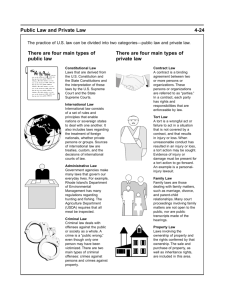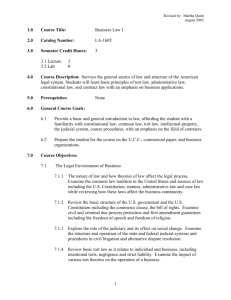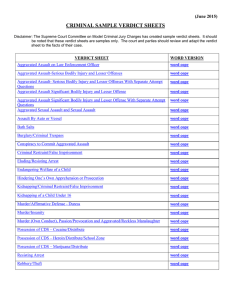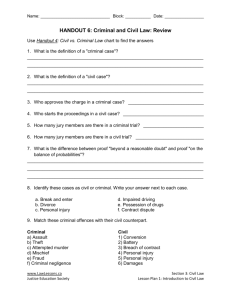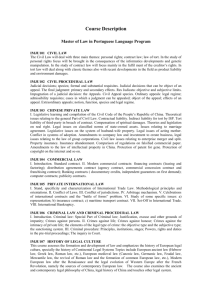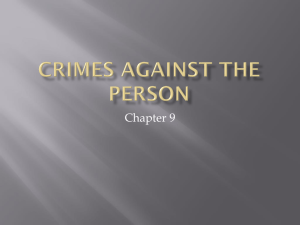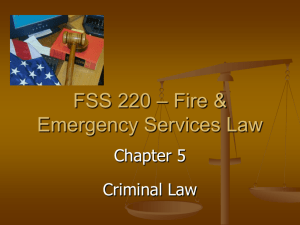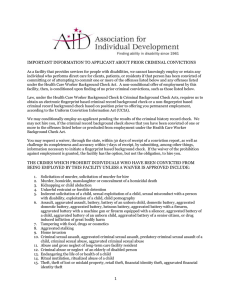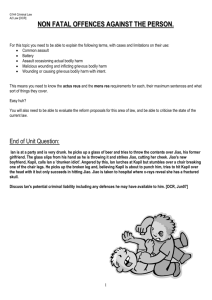Exam Review
advertisement
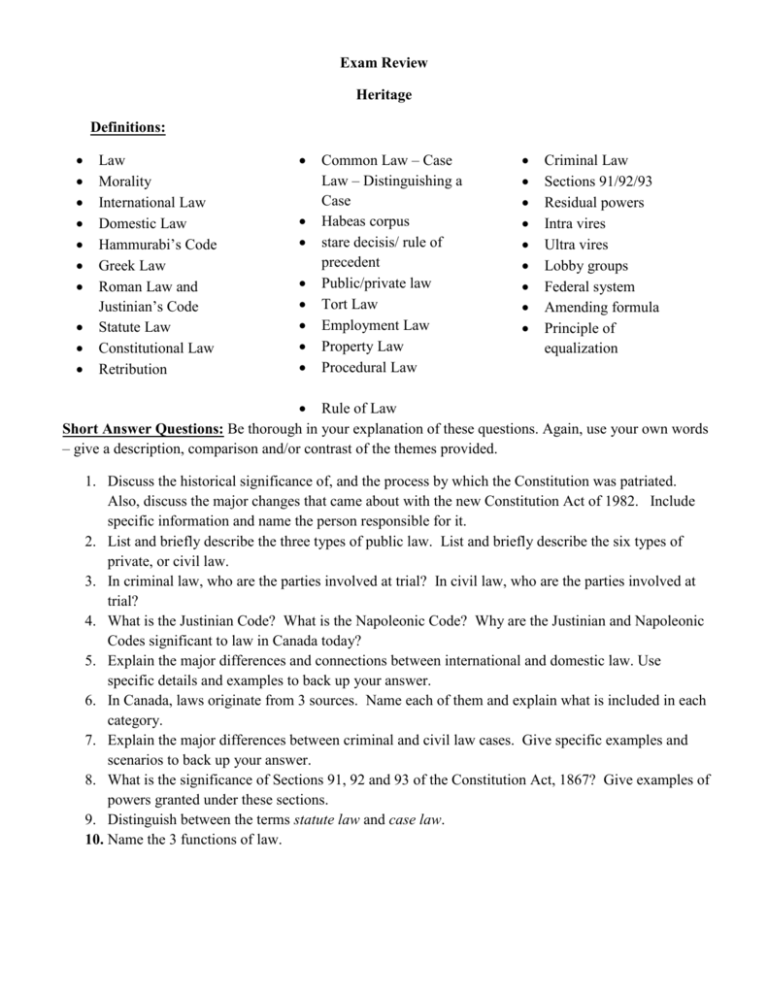
Exam Review Heritage Definitions: Law Morality International Law Domestic Law Hammurabi’s Code Greek Law Roman Law and Justinian’s Code Statute Law Constitutional Law Retribution Common Law – Case Law – Distinguishing a Case Habeas corpus stare decisis/ rule of precedent Public/private law Tort Law Employment Law Property Law Procedural Law Criminal Law Sections 91/92/93 Residual powers Intra vires Ultra vires Lobby groups Federal system Amending formula Principle of equalization Rule of Law Short Answer Questions: Be thorough in your explanation of these questions. Again, use your own words – give a description, comparison and/or contrast of the themes provided. 1. Discuss the historical significance of, and the process by which the Constitution was patriated. Also, discuss the major changes that came about with the new Constitution Act of 1982. Include specific information and name the person responsible for it. 2. List and briefly describe the three types of public law. List and briefly describe the six types of private, or civil law. 3. In criminal law, who are the parties involved at trial? In civil law, who are the parties involved at trial? 4. What is the Justinian Code? What is the Napoleonic Code? Why are the Justinian and Napoleonic Codes significant to law in Canada today? 5. Explain the major differences and connections between international and domestic law. Use specific details and examples to back up your answer. 6. In Canada, laws originate from 3 sources. Name each of them and explain what is included in each category. 7. Explain the major differences between criminal and civil law cases. Give specific examples and scenarios to back up your answer. 8. What is the significance of Sections 91, 92 and 93 of the Constitution Act, 1867? Give examples of powers granted under these sections. 9. Distinguish between the terms statute law and case law. 10. Name the 3 functions of law. Constitutional Law 1. Distinguish between prejudice, stereotyping, and discrimination 2. What are prejudices often based on? 3. Distinguish between intentional and unintentional discrimination. 4. Are Civil rights and human rights the same thing 5. Who was responsible for bringing in the Bill of Rights to Canada? 6. What were two weaknesses of the Bill of Rights? 7. What are the four fundamental freedoms? 8. What does section 15 guarantee? 9. What is section 28? Why is it different that section 15? 10. What is the difference between “striking down” and “reading down”? 11. Explain how the reasonable limits clause and the notwithstanding clause allow for rights and freedoms to be limited under the Charter. 12. Identify the main purpose of human rights legislation. 13. In the movie Philadelphia, what was the real reason that Andy Beckett felt he was fired for? 14. What is the purpose of the Charter of Rights and Freedoms? Who does it protect you from? 15. What is the difference between a “right” and a “freedom”? Define the following: Unlawful Assembly Infringed Amendments Franchise Prejudice (give an example) Stereotyping (give an example) Riot 13th Amendment (USA) Universal Declaration of Human Rights Criminal Law Terms to know: - Aggravated assault Aggravated Sexual Assault Assault Breaking and Entering Colour of Right Controlled Substance Culpable Homicide Disorderly Conduct First Degree Murder Fraud - Homicide Infanticide Mischief Money Laundering Non-culpable Possession Prostitution Second Degree Murder Sexual Assault Criminal Harassment Stalking What is the controlled Substance and Drug Act? What different types of identity theft are there? Types of Summary, Indictable, and Hybrid crimes with examples of each What is the difference between Culpable and Non-Culpable homicide and provide examples What is Obscenity? How does society deem what is or is not obscene? Provide examples. How many and what types of crimes are connected with prostitution? What are the different types of Property Crimes? What are the three types of Sexual Assault? What is Manslaughter? How is this charge proven in court? When is it “technically” breaking and entering? Terms to know: Alibi Secondary Crime Scene Accomplice C rime scene Protocol Forensic Direct Evidence Circumstantial evidence Miranda Warnings/Rights Police Conduct Burden of Proof Arraignment Conditional Discharge Insanity Mistake of Fact Necessity Mitigating Factors Youth Criminal Justice Act Warrant Section 10 (rights upon detention note) Duty Counsel Legal Aid undertaking Recognizance Disclosure Preliminary hearing Remand Plea Negotiation Bill of Indictment Absolute discharge Intermittent sentence Automatism Intoxication Duress Aggravating factors How does one obtain a warrant? How is a warrant used? What some reasons some one would be registered as a dangerous offender? What are some problems with having a criminal record? What is the difference between Aggravating and Mitigating Factors? Identify types sentences that a judge may hand down. Tort Law Terms: Plaintiff Defendant Litigation Litigants Tort Negotiation Arbitration General Damages Special Damages Punitive Damages Aggravated Damages Nominal Damages Mediation 1. Where do claims arise from in civil law? (What is the reason for the litigation?) 2. Explain how small claims court works? What are the limits (money) of claims? 3. How are crimes and torts alike? Provide 3 examples 4. What is the difference between Civil and Criminal law? (try to point out a minimum of 5 things) 5. What does the trial procedure look like? 6. Explain what garnishment means? 7. What are some alternative sources of compensation?
